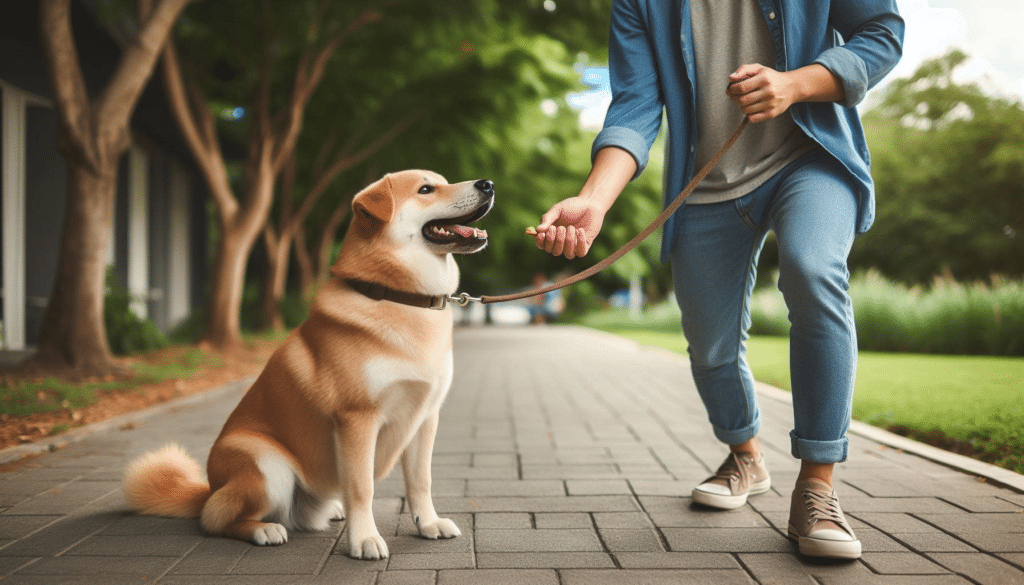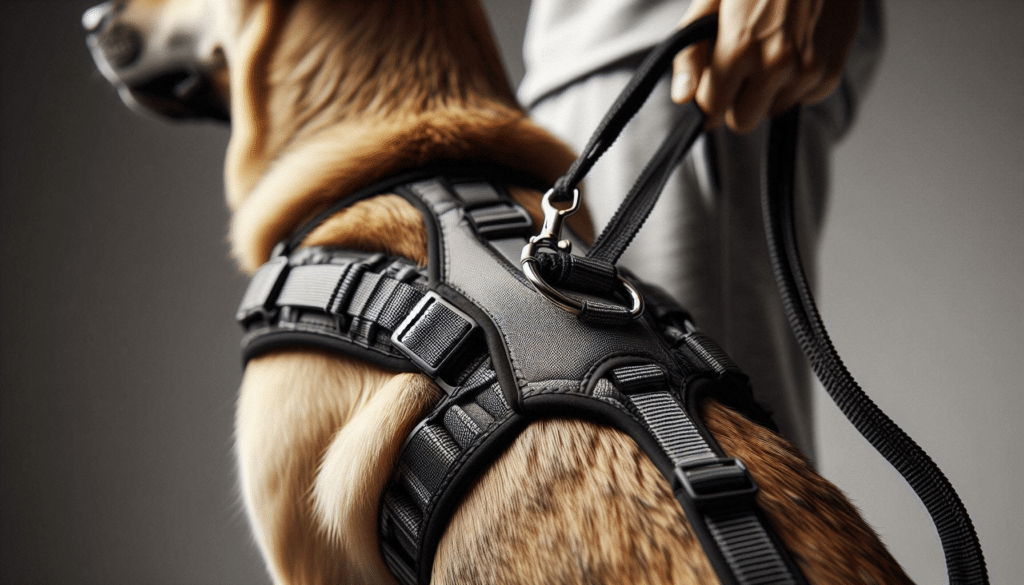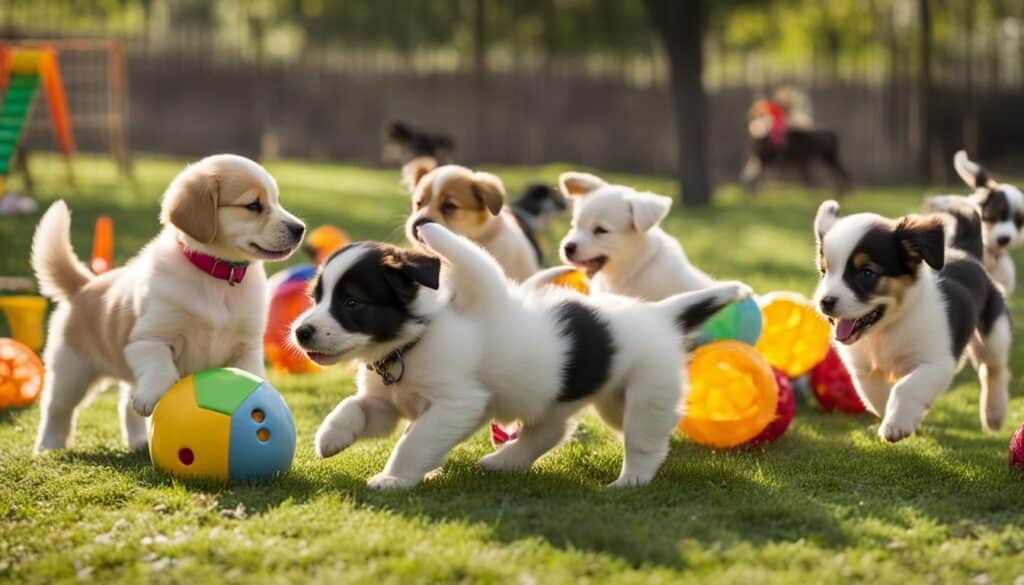Leash pulling can make walks with your dog frustrating and exhausting. If your furry friend constantly pulls on the leash, it’s time to take action and address this common issue. With effective leash training techniques, you can teach your dog to walk calmly by your side, making your walks more enjoyable for both of you.

This section will explore different strategies and tips to help your dog stop pulling on the leash. By understanding the psychology behind leash pulling, common triggers, and how your behavior affects your dog’s leash habits, you can begin to take the necessary steps to train your dog effectively.
Key Takeaways:
- Leash pulling can be addressed through effective training techniques.
- Understanding the psychology behind leash pulling is crucial for success.
- Common triggers, such as distractions, need to be identified and managed.
- Your behavior during walks plays a significant role in your dog’s leash habits.
- Consistency and positive reinforcement are key in leash training.
Why Does My Dog Pull on the Leash?
Understanding why dogs pull on the leash is crucial for addressing this common issue. This section will explore the psychology behind leash pulling and discuss the common triggers that lead dogs to pull on the leash. We will also examine how your behavior and reactions during walks can impact your dog’s leash habits.
Understanding the Psychology Behind Leash Pulling
Leash pulling is often rooted in a dog’s instincts and behavior. Dogs are curious creatures and are naturally inclined to explore their environment. When they are on a leash, the restriction can create frustration and drive them to pull in an attempt to reach something of interest. Additionally, dogs may pull on the leash to respond to fear or anxiety from unfamiliar surroundings or stimuli. By understanding these psychological factors, we can better address leash pulling through effective training techniques.
Common Triggers That Lead Dogs to Pull on the Leash
Several common triggers can cause dogs to pull on the leash. These triggers include encountering other dogs or animals, approaching exciting environments, or simply wanting to move faster than their human companion. Understanding these triggers can help us anticipate and manage leash-pulling situations effectively.
How Your Behavior Affects Your Dog’s Leash Habits
Believe it or not, your behavior and reactions during walks can significantly influence your dog’s leash habits. Dogs are highly perceptive and respond to your energy and cues. For example, if you tense up or become anxious when approaching a potentially triggering situation, your dog may pick up on this and react by pulling on the leash. On the other hand, if you remain calm and confident and provide clear guidance, you can positively influence your dog’s behavior and encourage loose leash walking. Recognizing the impact of your behavior and making necessary adjustments can significantly improve your dog’s leash manners.
Common Triggers That Lead Dogs to Pull on the Leash
| Trigger | Description |
| Encountering other dogs or animals | Dogs naturally have a strong desire to interact and investigate other animals. When they see another dog or animal while on a leash, their instinct may lead them to pull in excitement or curiosity. |
| Approaching exciting or stimulating environments | Dogs are attracted to new and interesting smells, sights, and sounds. When they sense an exciting or stimulating environment ahead, they may pull on the leash to explore it further. |
| Wanting to move at a faster pace | Dogs, especially high-energy breeds, may have a natural inclination to walk or run at a faster pace than their human companions. To satisfy their need for speed, they may pull on the leash. |
Choosing the Right Leash and Harness for Effective Training
The right leash and harness setup can be crucial to leash training success. This section will discuss the differences between harnesses and collars and determine which is sutable for a dog that pulls. We will also explore the role of leash length and material in training and provide tips on adjusting your leash setup for optimal training outcomes.

Differences Between Harnesses and Collars: Which Is Right Fit for a Dog That Pulls?
When choosing between a harness and a collar for a dog that pulls, there are a few key factors to consider. Harnesses distribute the pulling force across the dog’s body, reducing strain on their neck and throat. This makes harnesses an ideal choice for dogs prone to pulling or those with short or sensitive necks.
On the other hand, collars provide more control and can be a better option for dogs that have already been leash-trained or have a tendency to slip out of harnesses. They allow for quick corrections and are commonly used in obedience training.
Ultimately, the utmost choice between a harness and a collar depends on your dog’s needs, behavior, and comfort level. Consider consulting a professional dog trainer for guidance if you need more clarification.
The Role of Leash Length and Material in Training
Leash length and material are important considerations when training your dog to walk on a loose leash. A shorter leash provides more control and benefits dogs that tend to pull or become easily distracted. It allows you to guide your dog’s movements and provides a clear line of communication.
When it comes to leash material, opt for a strong and durable material that is comfortable for you and your dog. Nylon and leather are popular choices as they offer flexibility and durability. Avoid retractable leashes, which can encourage pulling and make it difficult to maintain consistent leash control.
Adjusting Your Leash Setup for Training Success
Adjusting your leash setup can significantly impact your training success. Here are a few tips:
- Ensure a proper fit: The harness or collar should fit snugly but not be too tight or restrictive.
- Use a double-ended leash: A double-ended leash provides more control by attaching to both the front and back of the harness, allowing you to steer your dog’s direction and discourage pulling.
- Practice leash management: Hold the leash with a relaxed grip, as tension can transfer to your dog and increase the likelihood of pulling. Regularly check your hand positioning and adjust as needed.
- Stay consistent: Use your chosen leash setup during training sessions and regular walks to reinforce positive behaviors and discourage pulling.
By choosing the right leash and harness, considering leash length and material, and adjusting your leash setup, you can set yourself and your dog up for success in leash training. Remember to remain patient, consistent, and positive throughout the process to create a calm and enjoyable walking experience for both of you.
Basic Training Techniques to Stop Your Dog from Pulling
To stop your dog from pulling on the leash, it’s essential to establish a strong foundation of basic training techniques. This section will guide you through the critical steps to introduce your dog to loose leash walking, effectively use positive reinforcement, and teach the “heel” command as the core of polite leash behavior.
How to Introduce Your Dog to Loose Leash Walking
Introducing your dog to loose leash walking is an essential first step in addressing leash pulling. Start by choosing a quiet and familiar environment for your training sessions. Use a properly fitting harness or collar and a standard leash to ensure comfort and control.

Begin by strolling with your dog on a loose leash. When your dog starts to pull, stop walking and wait for them to return to your side. Reward your dog with praise or a small treat when they return to the desired position. Gradually increase the distance and duration of your walks, ensuring your dog maintains a loose leash.
Using Positive Reinforcement to Encourage Good Behavior
Positive reinforcement is a highly effective training technique that enables you to encourage and reinforce good behavior in your dog. When your dog walks calmly on a loose leash, reward them with verbal praise, petting, or treats. These rewards create positive associations and motivate your dog to repeat the desired behavior.
Remember to provide immediate rewards when your dog exhibits good leash behavior, reinforcing the connection between their actions and positive reinforcement. Be consistent with your rewards and gradually reduce their frequency as your dog becomes more proficient at walking on a loose leash.
Teaching “Heel” Command: The Foundation of Polite Leash Behavior
The “heel” command is an essential cue that teaches your dog to walk next to you with focus and attention. Start by choosing a side for your dog to walk on, and consistently use the same side during training sessions. Begin walking and say “heel” in a clear and confident tone. When your dog walks beside you without pulling, reward them with praise and treats.
Practice this command in various environments with increasing distractions. As your dog responds more consistently to the “heel” command, gradually reduce the frequency of treats and rely more on verbal praise and petting. With consistent practice, your dog will learn to walk politely by your side, resulting in a more enjoyable walking experience for both of you.
Advanced Strategies to Train Your Dog to Walk Nicely
This section will explore advanced strategies to train your dog to walk nicely on the leash. Walking your dog without pulling can be challenging, but with the proper techniques, you can achieve a pleasant walking experience for you and your furry friend.
Changing Directions and Speed to Keep Your Dog’s Attention
One effective technique to prevent pulling is frequently changing directions and varying speed. Doing so can keep your dog engaged and focused on you, reducing the likelihood of pulling. Dogs are naturally curious and attentive to changes in movement, so using this to your advantage can be highly beneficial during walks.
During your walk, try incorporating random turns and sudden speed changes. Your dog must pay attention and follow your lead rather than pulling ahead. As your dog becomes more accustomed to these direction and speed changes, they will be more responsive and less prone to tearing.
What to Do When Your Dog Pulls: Immediate Correction Techniques
Despite your enough efforts, there may be instances when your dog pulls on the leash. It is essential to address this behavior immediately to prevent it from becoming a habit. When your dog pulls, use a firm but gentle technique called a “correction.” This involves a slight tug on the leash followed by a release of tension, redirecting your dog’s focus back to walking beside you.
It is crucial to use the correct timing and pressure when applying the correction technique. Pulling too harshly or inconsistently can cause discomfort or confusion for your dog. Practice this technique during training sessions to ensure proper execution when walking.
How to Use Distractions as Training Opportunities
Walking your dog in a distracting environment can be challenging but also presents valuable training opportunities. By exposing your dog to various distractions, such as other dogs, squirrels, or busy streets, you can work on reinforcing their obedience and focus on the leash.
When encountering distractions, remain calm and maintain control of the leash. Use positive reinforcement techniques, such as treats or verbal praise, to reward your dog for maintaining good behavior and ignoring distractions. Over time, your dog will learn to resist the urge to pull and stay focused on you, even in the presence of distractions.
These advanced strategies, including changing directions and speed, employing immediate correction techniques, and using distractions as training opportunities, will improve your dog’s leash behavior. Patience, consistency, and plenty of practice will be critical to successfully training your dog to walk nicely on the leash.
Common Mistakes in Leash Training and How to Avoid Them
Leash training can be challenging, but avoiding common mistakes can make the process smoother and more effective. In this section, we will discuss some of the most common mistakes dog owners make in leash training and provide guidance on how to avoid them.
Why Consistency is Key to Training Your Dog Not to Pull
Consistency plays a crucial role in leash training. Dogs thrive on routine and clear expectations, so it’s essential to establish and stick to consistent training methods. Inconsistent training can confuse your dog and hamper their progress. Set clear rules and boundaries for your dog’s behavior on the leash and ensure everyone follows them consistently.
Avoiding Overcorrection: Finding the Balance
Overcorrection can hinder your dog’s leash training progress. While it’s essential to correct undesirable behavior, it’s equally crucial to find the right balance. Overcorrection, such as excessive forceful methods or punishments, can lead to fear or mistrust in your dog, making the training process more challenging. Instead, focus on positive reinforcement and reward-based training techniques to encourage desired behavior.
Why Punishment Doesn’t Work and What to Do Instead
Punishment is not an effective method in leash training. Dogs do not understand punishment as humans do, which can create fear and anxiety, negatively impacting their learning experience. Instead of punishment, focus on positive reinforcement and reward-based techniques. When your dog exhibits good leash behavior, reward them with treats, praise, and affection. This positive association helps them understand what is expected and encourages them to repeat the desired behavior.
A study conducted by researchers at the University of Porto found that dogs trained using aversive stimuli (such as punishment) showed higher stress levels compared to those trained with reward-based methods (primarily positive reinforcement)
When to Seek Help from a Professional Dog Trainer
If you face challenges in leash training and need additional support, it may be time to seek help from a professional dog trainer. While many dog owners can successfully train their pets independently, some situations call for the expertise and guidance of a trained professional.
Signs That It’s Time to Get Professional Help
Several signs indicate the need for professional assistance in leash training. If your dog’s pulling behavior persists despite your enormous efforts or you feel overwhelmed and frustrated with the training process, it clearly indicates that seeking professional help is beneficial. Additionally, if your dog exhibits fear, aggression, or other behavioral issues during walks, it’s crucial to involve a dog trainer who can address these specific challenges.
What to Expect from Professional Leash Training Sessions
When you engage a professional dog trainer for leash training, you can expect personalized guidance tailored to your dog’s unique needs. A trainer will assess your dog’s behavior, analyze the root causes of leash pulling, and design a customized training plan to address these issues effectively. The training sessions will focus on teaching you the proper techniques, providing practical exercises to practice at home, and offering continuous support and feedback throughout the training process.
How a Dog Trainer Can Improve Your Dog’s Leash Behavior
A trained and experienced dog trainer has the knowledge and skills to effectively improve your dog’s leash behavior They understand the psychology behind leash pulling and can employ positive reinforcement techniques to encourage good behavior. A trainer will also help improve your communication with your dog, strengthen your bond with your furry friend, and create a positive and enjoyable walking experience for both of you. You can overcome leash training challenges and achieve long-lasting results with professional guidance.
FAQs
Q: How can I teach my dog to walk nicely on a leash without pulling?
A: To teach your dog to walk nicely on a leash, choose a quiet area to minimize distractions. Use a short leash to keep your dog close and allow better control. Stop walking immediately when your dog starts pulling, and wait to move until the leash is slack. This teaches your dog that pulling won’t get them where they want to go. Reward your dog with treats and praise whenever they walk nicely beside you with slack on the leash.
Q: How can I train my dog to stop pulling on the leash?
A: One effective technique is changing direction whenever your dog pulls. This unpredictability keeps your dog’s attention on you rather than their surroundings. Also, practicing the “stop and stand still” method teaches your dog that pulling leads to the opposite of what they want – moving forward. Consistent practice and rewarding calm, non-pulling behavior are essential.
Q: Can certain types of leashes and collars help with leash training?
A: Yes, certain types of leashes and collars can aid in leash training. A well-fitted harness with a front attachment point can discourage pulling, so gently steer your dog back toward you when they pull. Training collars, such as prong collars or gentle leaders, can also be effective but should be used under professional guidance to prevent harm.
Q: How can I teach my dog to stop pulling as soon as the leash goes on?
A: Start by teaching your dog that the leash means it’s time for a calm walk. Before leaving the door, wait for your dog to stop excited behavior and sit calmly. Only proceed with putting on the leash and collar and going out the door once your dog is calm. This sets a precedent that leash time equals calm behavior.
Q: How do I give my dog enough freedom to sniff and explore without pulling on the leash?
A: Balancing leash training and allowing your dog to explore is essential. Use a command like “Go sniff” to tell your dog when it’s okay to explore. Keep these exploration moments brief, and then signal your dog to return to your side. This way, your dog learns there’s a time for walking calmly and a time for sniffing around without the need for pulling.
Q: What should I do if my dog starts pulling towards another dog or person?
A: If your dog starts pulling towards something, immediately turn and walk in the opposite direction. This teaches your dog that pulling will not get them to their desired destination. Once your dog is walking nicely again, approach the person or dog slowly, rewarding for calm behavior. If your dog can’t approach without pulling, it’s back in the opposite direction until they calm down.
Q: How long will training a dog to stop pulling on the leash take?
A: The time it takes to train a dog to stop pulling on the leash varies significantly from one dog to another. Consistency is vital; daily training sessions are more effective than less frequent longer sessions. Be prepared for it to take several weeks to months of consistent effort. Remember, every dog is different, and patience is crucial.
Q: Why does reducing tension on the leash matter in dog training?
A: Reducing tension on the leash is important because it communicates to your dog that they are walking nicely. Tension on the leash often signals a dog to pull back or struggle against it. Training your dog to walk with a loose leash tells them they are doing the right thing, which is critical for practical leash training.

